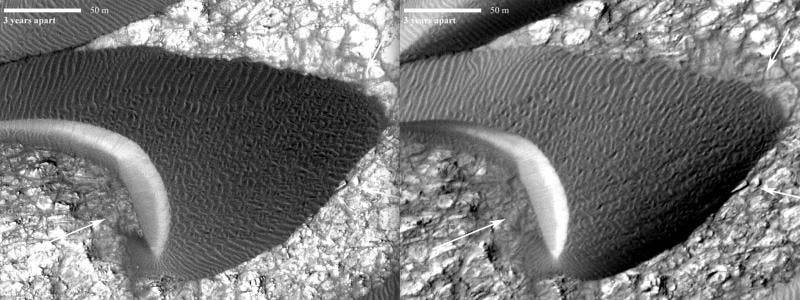NASA’s Mars Reconnaissance Orbiter has revealed yet another surprising fact about our red neighbor: movement in sand dunes occurs on a large scale, about the same as in dune fields here on Earth.
This is totally unexpected because Mars has a much thinner atmosphere than our planet, and high speed winds are much less common than here as well; researchers have debated for years if the sand dunes we see on Mars today are a remnant of past times or rather an evidence of active phenomena, and this observation seems to finish this debate once and for all.
Mars Reconnaissance Orbiter’s High Resolution Imaging Science Experiment (HiRISE) camera has detected sand dune movement, confirming dunes as thick as 61 meters are moving as coherent units across the Martian landscape.
“This exciting discovery will inform scientists trying to better understand the changing surface conditions of Mars on a more global scale,” said Doug McCuistion, director, NASA’s Mars Exploration Program, Washington. “This improved understanding of surface dynamics will provide vital information in planning future robotic and human Mars exploration missions.”
Researchers basically analyzed before and after images using a new software tooldeveloped at the California Institute of Technology (Caltech) in Pasadena. What the tool does is analyze changes and movements of the sand ripples revealing the ripples move faster the higher up they are on a dune. They then used the filter to analyze images from 2007 and 2010 of the Nili Patera sand dune field located near the Martian equator. By correlating the ripples’ movement to their position on the dune, the analysis determined the entire dunes are moving. This also allows them to estimate the size and volume of the moving sand.
“We chose Nili Patera because we knew there was sand motion going on there, and we could quantify it,” said Nathan Bridges, a planetary scientist at Johns Hopkins University Applied Physics Laboratory in Laurel, Md., and lead author of the Nature paper. “The Nili dunes also are similar to dunes in places like Antarctica and to other locations on Mars.”
“Our new data shows wind activity is indeed a major agent of evolution of the landscape on Mars,” said Jean-Philippe Avouac, Caltech team leader. “This is important because it tells us something about the current state of Mars and how the planet is working today, geologically.”
Researchers hope to use this newly obtained knowledge to find out more about the mysteries which shroud Mars







